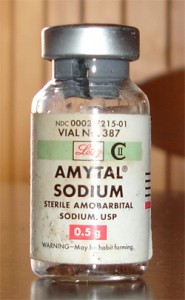by Jack El-Hai
Remember the routine from black and white espionage dramas of the 1940s and ‘50s? The bad guys detain a suspected spy, who won’t talk even after a rough interrogation. Soon, after receiving an injection of a colorless liquid, he’s muttering uncontrollably, spilling the details of an entire network of agents. The truth serum has done its job.
 No drug has ever really worked this way. In 1916 Robert House, a Texas obstetrician, chanced upon the first pharmacological agent that appeared to put people in an unusual trance. He noticed that some of his patients who received the anesthetic scopolamine during delivery fell into a half-sleep in which they could sometimes answer questions without remembering having done so afterward. House grew convinced that their mental state under scopolamine’s influence was one in which it was impossible to lie — therefore, the drug could compel anyone to speak the truth.
No drug has ever really worked this way. In 1916 Robert House, a Texas obstetrician, chanced upon the first pharmacological agent that appeared to put people in an unusual trance. He noticed that some of his patients who received the anesthetic scopolamine during delivery fell into a half-sleep in which they could sometimes answer questions without remembering having done so afterward. House grew convinced that their mental state under scopolamine’s influence was one in which it was impossible to lie — therefore, the drug could compel anyone to speak the truth.
Like alcohol, scopolamine and the truth serum substitutes that would soon follow it depressed the central nervous system and diminished inhibitions. There was no greater guarantee of reliable truthfulness in House’s patients than in any soused person.
Undeterred by his lack of knowledge of psychology, pharmacology, or criminology, House spent the 1920s touring America’s jailhouses and police departments in demonstrations of administering scopolamine in the questioning of criminal suspects. He believed the drug would prove useful in the justice system not as a tool to make tight-lipped crooks talk, but as part of an interrogation technique that would give police investigators no excuse to use violence to extract confessions.
After House’s death in 1929, the use of scopolamine and later truth serums — sodium amytal and sodium pentothal — changed course. In an era of rising organized crime, the police wanted confessions. But the drugs made people suggestible and prone to giving fanciful and wrong answers. Over the years, some interrogators who continued using these drugs, despite numerous cases of false confession, crossed a line into abuse of suspects and miscarriage of justice. “The criminal who is likely to confess under sodium amytal is likely to confess anyway if skillfully interrogated,” the psychiatrist John M. MacDonald concluded in 1955. “The criminal who is able to withstand skillful interrogation is usually able to withstand examination while under the influence of drugs. The temptation to request a truth serum test as a short cut to the solution of a crime should be avoided.”
In its Townsend v. Sain decision of 1963, the U.S. Supreme Court ruled that confessions obtained using a truth serum were inadmissible. After the 9/11 terrorist attacks, some law-enforcers called for a return to truth-serum interrogation. So far, nobody has publicly announced the development of a drug formulation proven to work.
Sources:
MacDonald, John M. “Truth Serum.” Journal of Criminal Law, Criminology, and Police Science, Vol. 46, 1955-1956, pp. 259-263.
Winter, Alison. “The Making of ‘Truth Serum.'” Bulletin of the History of Medicine, Vol. 79, No. 3, Fall 2005, pp. 500-533.
